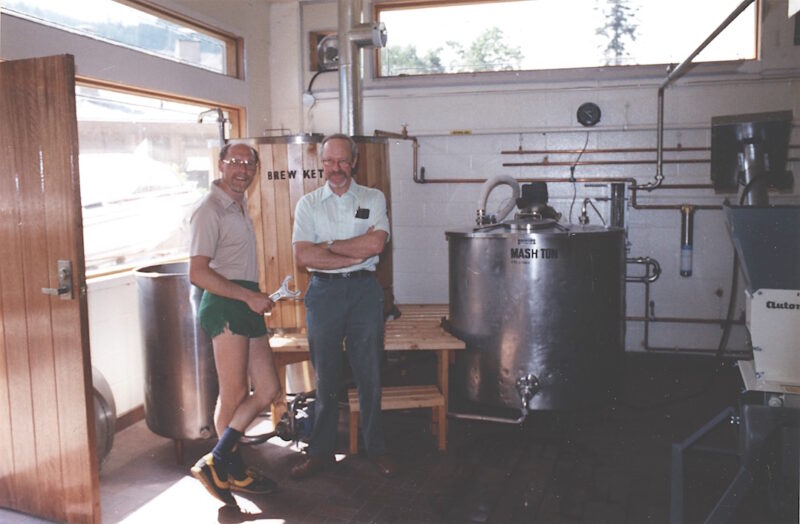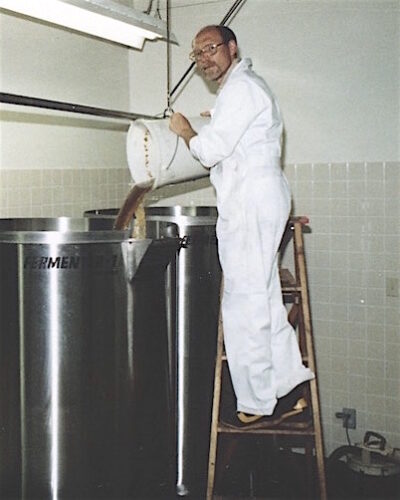#49 Talk is cheap, beer is better
Brewing Revolution: Pioneering the Craft Beer Movement
by Frank Appleton
Madeira Park: Harbour Publishing, 2016
$24.95 / 9781550177824
Reviewed by Joe Wiebe
First published No. 28, 2016
*
 In 1978 the back-to-the-land magazine Harrowsmith published a subversive how-to article, “The Underground Brewmaster.” It was written by Frank Appleton of Edgewood, formerly a supervisor at O’Keefe Brewery in Vancouver. In it, Appleton revealed how to brew beer at home and avoid the tasteless and bland commercial suds.
In 1978 the back-to-the-land magazine Harrowsmith published a subversive how-to article, “The Underground Brewmaster.” It was written by Frank Appleton of Edgewood, formerly a supervisor at O’Keefe Brewery in Vancouver. In it, Appleton revealed how to brew beer at home and avoid the tasteless and bland commercial suds.
Here, reviewing Appleton’s Brewing Revolution: Pioneering the Craft Beer Movement, Joe Wiebe charts a commercial brewing revolution that started in 1982 when Frank Appleton and John Mitchell teamed up to start the Horseshoe Bay Brewery, Canada’s first micro-brewery –Ed.
*
There are more than 120 craft breweries in British Columbia. To put that in context, when my own book, Craft Beer Revolution: The Insider’s Guide to B.C. Breweries, was published in 2013, it included 50 breweries.
At my Vancouver book launch I jokingly called out brewmaster Brent Mills for making my book out of date because he had just opened Four Winds Brewing a few days earlier. But that was just the first of many to follow. The second edition, published in 2015, included 90 breweries. It’s virtually impossible to keep up with all the new ones, but I’m not complaining: there’s never been a better time to drink beer in British Columbia.

But this was not always the case. Go back to the 1970s and there was no such thing as a “craft brewery.” No one had even invented that term yet. Beer was produced almost exclusively by three national companies — Carling O’Keefe, Labatt and Molson — who shared the marketplace almost equally, matching each other’s prices, and brewing pretty much the same bland, pale yellow product as each other.
This uninspiring landscape was the breeding ground for the Horseshoe Bay Brewery, Canada’s first so-called “microbrewery,” a label devised by the government to differentiate it for taxation purposes. Horseshoe Bay was built in 1982 by two men now considered to be the founders of craft brewing in BC: Frank Appleton and John Mitchell; it was Mitchell’s idea, but Appleton was the one who actualized it.
While Mitchell’s version of this story has been well told in published articles and books (including my own), Appleton’s part of the story has not been shared — until now. Brewing Revolution, Frank Appleton’s memoir of his life in brewing, is a fascinating story that is both entertaining and informative, and the perfect complement to a glass of your favourite local brew.
Born in Manchester, England, in 1941, Frank Appleton earned a technical college diploma in microbiology and found work in a lab that was part of a big company that processed corn from the United States into a wide variety of products, including glucose, corn starch and corn oil. He enjoyed the work for a time, but as a young man in his 20s, he was not content to stay in his hometown. He had long been fascinated by Canada, and with a sister living in Vancouver, he decided to give it a try.

Appleton loved his new home: “Exchanging grimy, industrial Manchester for beautiful, clean Vancouver, set between mountains and the sea, was a revelation in itself. You could go skiing and play tennis on the same day! I had my own apartment overlooking the beach in Kitsilano and my own car. What could be better?”
He was “overjoyed” to find work as a quality control supervisor at the O’Keefe Brewery in Vancouver in 1964. It was an exciting time because they “were launching O’Keefe brands in BC for the first time.” He enjoyed his role and the colleagues he worked with, and was proud of the quality of the beer they produced there. But as the years went by, the company changed and the beer went downhill. Appleton grew bored with his work and began writing on the side “to divert [his] gloomy thoughts,” first some technical papers that were published in the brewing press, and then an article for Saturday Night magazine that criticized Vancouver mayor Tom “Terrific” Campbell for his attempts to clear draft dodgers and protestors out of the city’s new downtown square. This earned Appleton disfavour with his bosses at the brewery, and in 1972, he decided to quit his job, “drop out,” and homestead on “20 acres of treed hillside in a remote valley in the Kootenays.”

Over the next decade, he cleared the land and built his own home there. To support himself, he took up freelance writing and became a regular contributor to Weekend Magazine, a full-colour Saturday supplement that appeared in many newspapers across the country, as well as Harrowsmith, which was “aimed at alternative-lifestyle, back-to-the-land folks,” perfect for his talents and interests. In 1978 he wrote an article for Harrowsmith called “The Underground Brewmaster,” which “told people to start brewing their own beer, since not only was it much cheaper than the product from the liquor store… if you did it right, you could make a better, more satisfying drink than what the big guys produced.” It was more than just a how-to article—it was practically a manifesto, a call-to-brew at a time when the marketplace was dominated by the Big Three breweries and their insipid products.
“It took almost three years for the spark to find the right kindling,” Appleton writes, but when it did, that spark started the craft beer revolution here in British Columbia that is still going strong today.
In 1981, John Mitchell, another ex-pat from England, was running the Troller Pub in Horseshoe Bay. Unhappy with the lack of beer options available to him, especially each time the workers at the Big Three breweries went on strike, which was often, Mitchell decided to build his own brewery, but he had no idea how to do that. When a friend showed him “The Underground Brewmaster,” Mitchell knew he needed to conscript Frank Appleton to help him out.
During their first phone conversation, Appleton was sceptical of “this guy who had no idea what he was getting into,” but Mitchell was persistent: he immediately drove 600 km to Edgewood to meet with Frank at his home. The two connected quickly, despite their different class backgrounds and Appleton’s hippy lifestyle, which ran counter to Mitchell’s more conventional, stiff-upper-lip attitude. They worked together, first to apply for permission and then to build the Horseshoe Bay Brewery.
The chapters focused on the relationship between Frank Appleton and John Mitchell are where this book really comes alive: the vitality of their combined effort to create something fundamentally new carries through to the present, and the bond the two men developed in doing so still resonates today. There’s a playful, brotherly sort of fondness in the way Appleton portrays Mitchell in his book, poking fun at him with clear admiration shining through at the same time. And B.C. beer lovers will enjoy learning even more details about those early days of the craft beer revolution.
After the Horseshoe Bay Brewery opened, Appleton returned home to the Kootenays, not expecting that he “would be kept busy for the next twenty years designing and bringing on-stream brewpubs and microbreweries in Canada, the US and France.” But that was exactly how he spent the 1980s and 1990s in a career that evolved and grew with the advent of the microbrewing movement. For a time, he was one of the world’s leading microbrewery consultants, responsible for building the breweries at Swans Brewpub (Victoria), Yaletown Brewing (Vancouver), Tin Whistle Brewing (Penticton), Deschutes (Bend, OR), Ninkasi Ale House (Lyon, France), and several other operations.
While Brewing Revolution is certainly an engaging read for anyone who likes beer, it is also filled with technical suggestions and tricks of the trade that will be especially interesting for home brewers or those aspiring to be professional brewers themselves. Throughout, Appleton’s style is entertaining and easy to read. He is especially deft at handling dialogue, bringing to life scenes from his past with a cinematic clarity. All in all, this book is a welcome addition to any beer lover’s library.
*

Joe Wiebe, the Thirsty Writer, is the author of Craft Beer Revolution: The Insider’s Guide to B.C. Breweries (Douglas & McIntyre, 2013), the definitive guidebook to BC’s burgeoning craft beer industry and a BC bestseller. A freelance writer for more than 15 years, Joe has written hundreds of articles on a wide range of subjects including arts, culture, sports, business, and travel, but since 2008 he has mainly written about craft beer with regular columns for the Northwest Brewing News, Vancouver View, UrbanDiner.ca, and the BC Craft Beer News, as well as beer-soaked stories in British Columbia magazine, BC Business, WestWorld, Beer West, Taps, Publican, NUVO, Taste, and Boulevard. A co-founder of Victoria Beer Week and the BC Ale Trail project, Joe also produced the Victoria Beer Map and is the beer columnist for CBC Radio’s All Points West and BC Almanac programs. He hosts panel discussions on craft beer, emcees a Business of Craft Beer conference, and presents his Craft Beer Revolution seminars in throughout BC.
*
The Ormsby Review. More Books. More Reviews. More Often.
Publisher and Editor: Richard Mackie
The Ormsby Review is a journal service for in-depth coverage of B.C. books and authors. The Advisory Board consists of Jean Barman, Wade Davis, Robin Fisher, Cole Harris, Hugh Johnston, Patricia Roy, David Stouck, Maria Tippett, and Graeme Wynn. Scholarly Patron: SFU Graduate Liberal Studies. Honorary Patron: Yosef Wosk. Provincial Government Patron since September 2018: Creative BC
“Only connect.” – E.M. Forster
One comment on “#49 Talk is cheap, beer is better”
Comments are closed.